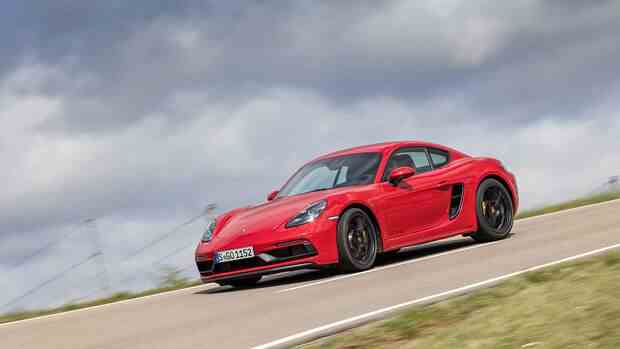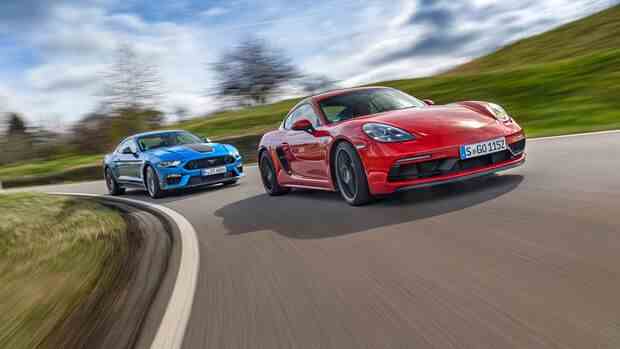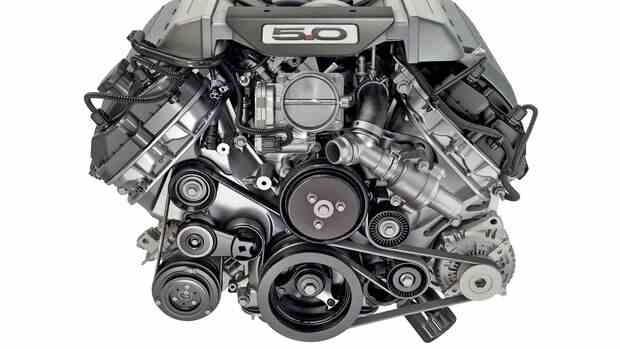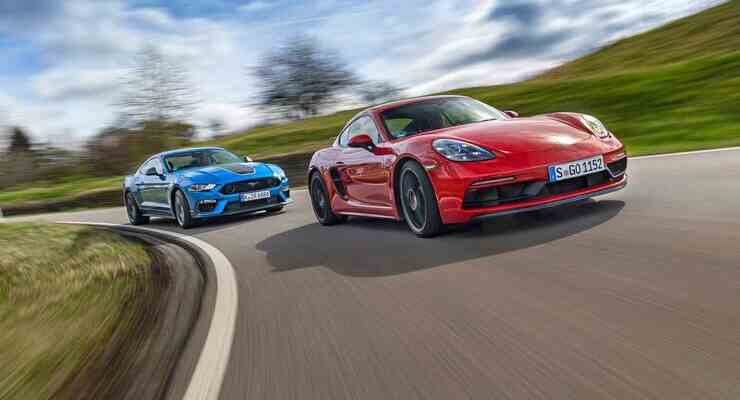Ford Mustang Mach 1 & Porsche 718 Cayman GTS 4.0
Bubbling V8 versus sawing naturally aspirated engine
Rather unlikely that we have to act as a purchase advisor here. Finally, both the Ford Mustang Mach 1 coupe and the Porsche 718 Cayman GTS 4.0 for real brand fans who would probably never be interested in the other athlete. So the roles are clearly divided – grown for years, even decades, if you will. And yet the Mustang in the form of the Mach 1 shakes the cliché of the V8 American who can only do 1/4 mile. A lot still revolves around the drag strip.
Yes, the Americans are crazy enough to program a line-lock mode into the Mustang’s digital brain: the front axle bites into the asphalt, while the rear rubber sticks dissolve in smoke and rips chunks out of the decrepit asphalt. At best, that would be property damage. That’s why we spare the test car this martyrdom before the measurements. Because we’re a) convinced that the show would torpedo the driving dynamics metrics, and b) it wouldn’t be the first Mustang to leave some of its components on our runway.
Mach 1: King of Drag Strip?
But the show must go on. This is how the unadorned runway in Lahr becomes a drag strip: In the mode of the same name, which relinquishes the mechanical component protection and preloads the magnetic ride chassis, things should go the fastest. For this purpose, Ford stages a tape speedometer with start lights in the digital cockpit and installs a launch control with variable speed management and customizable shift point display. So step on the gas, wait for the countdown while the V8 rolls in. Then he pushes off and shakes the entire Rhine Valley with the volleys of his four-pipe exhaust system. It’s just stupid that the Americans could have saved themselves all the effort, because you’re not really fast that way. In order to really get the Mustang off to a flying start, you have to model the gas pedal with feeling, otherwise the 460 hp and 529 Nm of torque will fizzle out.
Achim Hartmann
Ford Mustang Coupé V8 Mach 1: 460 hp, 529 Nm, 1/4 mile in 13.3 s, Vmax 270 km/h, weight 1,757 kg, test car price: 67,000 euros.
With traction control disabled, the Mach 1 braces itself with a slight slip on the tarmac. If you don’t rip through the gears, the speed drops to the middle shoals. It’s good that Ford uses the circuit with shortened paths from the Shelby models. But their leadership requires muscle power and precision, otherwise the time is gone. The Mach 1 runs over the 100 mark after 5.4 seconds. A bit disappointing, since Ford promises sprint times of less than five seconds. And yet: a real experience that is unparalleled in the old world. Of the 718 Cayman, on the other hand, simply ticks off this exercise.
He presses the rear wheels onto the asphalt with the weight of his low-lying six-cylinder boxer, logs the analog launch-controlled rev needle on the red five and snaps off just as quickly as you lift your foot off the clutch pedal. None of the 400 little horses paws their hooves here, instead the sucker screeches in the driver’s ear and roars at outsiders with the exhaust system of the GT 4 model.
The act of acceleration itself is told briskly: the gear lever shoots straight through the short streets, just as if it weren’t hanging on ropes, but were an extension of the right arm that had become a pole. That’s why it all feels a little less brutal. In addition, the GTS 4.0 is instantly, repeatably and reliably exactly one second faster than the Mustang. A lead that the Porsche doubles up to a speed of two hundred. And only at 293 instead of 270 km/h does the Porsche fail because of the natural air wall.
And the other way around? What do you think? The GTS undercuts the extremely respectable 33.6 meters braking distance from 100 km/h of the Mach 1 by 2.1 meters thanks to the optional PCCB – without semislicks or other legal tricks. It’s just stupid that the option, which costs 7,319 euros, can’t be ordered at the moment. But rest assured: Even with the steel system, the 718 brakes superbly, at least as long as you don’t regularly hang around on any trackday courses.
Driving dynamics nerd
That’s where it’s going. The Cayman continues the party on the handling course in Boxberg: It’s almost unbelievable how precisely the Porsche steers, how playfully it wraps around corners like a dancer around the pole dance pole! No matter what radii, no matter what speed: turn in and the Cayman follows, sticking to the ideal line. The Race-Tex-covered steering wheel becomes the pivot and the shift knob the pivot. The high-speed vehicle can be spiced up a bit. Simply lift the gas pedal briefly, then the load change impulse turns the short snout further in the direction of the apex. What used to mean a safe departure for a mid-engine athlete without Röhrl’s driving genes can now be converted relatively easily into a nice powerslide with a burst of gas. It’s wonderful how quickly the short-stroke 4.0-liter boxer responds! You are not on the road faster, but you free yourself from the nerdy high-speed efficiency.

Achim Hartmann
Porsche 718 Cayman gts 4.0: 400 hp, 420 Nm, 1/4 mile in 12.4 s, Vmax 293 km/h, curb weight 1,406 kg, test car price: 97,987 euros.
However, the Cayman benefits from this in the driving dynamics measurements: Here it dances through the pylon lanes at 146 km/h and sweeps around the cones in the 18-meter slalom at 71 km/h, also faster than the somewhat bulky Mach 1. Sure, At 4.80 meters, the Mustang is 39 centimeters taller than the 718 and, at 1,757 kg, weighs around seven hundredweight more than the mid-engine athlete. Sounds like a straightforward matter.
But the Mach 1 also has fine handling qualities. The Ford Performance guys have tightened the standard Magnetic Ride chassis for the European market, but they don’t trim it down to the hard, less than hearty 718 level. So the Mach 1 setup moves more than the Porsche when cornering. But that can also be understood as communication. In any case, with its 275 rear wheels and the Shelby rear axle locking differential, it builds up a lot of traction, even when winter tires at the rear have to parry a sudden onset of winter.
Especially on bumpy, winding country roads you don’t lose touch completely. This is also due to the steering, which implements impulses directly. Away from the race track, it hardly bothers that she gives less feedback. It’s just a pity that you slip around unrestrainedly on the couchy standard seats. Yes, the better place to work is in the Porsche: It starts with the low position in the bucket seats, which cost over 5,355 euros and can only be adjusted lengthways and in height. Why? Well, because other positions are simply not necessary. You can only sit even better if you have a 3D body cast made by Porsche. No joke: That goes for another 2,677 euros.
Only one price is hot
As you can see, it gets expensive when you shop in Zuffenhausen. The GTS 4.0 costs around 85,000 euros as an almost bare basis; In addition, there are evaluation-relevant driving dynamics extras of around 13,000 euros. If you try to bring it up to the all-inclusive level of the 67,000 euro Mustang, you quickly break through the 100,000 mark.

Achim Hartmann
The Mustang Mach 1 clearly missed the factory specification by a radical 5.4 seconds, despite the special drag-strip mode. The Cayman GTS 4.0 is exactly one second faster with Launch Control.
In contrast to the good-but-cheap US interior, the processing of the German engineer’s mobile is correct here. The materials also appear to be of high quality, and the manufacturing department really fulfills all wishes. You can also stick retro stripes on the Cayman, which make the Mach 1 look good as standard.
Too antiquated? Only the button-rich, somewhat coarse-pixel Porsche infotainment that only connects to Apple, charges Android smartphones inductively and can be used unerringly works. In contrast, confusion prevails in the Ford: the engineers simply pin countless buttons for the cruise control, complex on-board computer or pony mode to the steering wheel of the Mustang. And the old Sync 3 infotainment reigns in the center console, which primarily wants to be touched because it ignores voice commands.
The space available is more practical: Where the engine sits in the 718, children can spread out on Isofix seats in the Mustang. In addition, the fastback not only stows weekend purchases behind the narrow flap, but also folds down the two-piece rear seat backrest for bulkier items that would never fit into the two trunks of the 718. In addition, the Mustang is more recommended as a daily driver, which keeps the exhaust flap closed during a cold start in neighborhood mode. Speaking of everyday life. The coupés are even economical here: Both achieve single-digit consumption values on the Eco lap. With which we do not want to refute the myth of the thirsty V8 and boxer, because if you move the athletes in a species-appropriate manner, consumption usually oscillates around twelve liters per 100 km and more. Whereby the boxer always burns a little less super – so much buying advice must be.
The naturally aspirated engine concert
Of course, the Mustang and Cayman are also available with turbocharged four-cylinder engines. But who wants that if you can drive high-capacity naturally aspirated engines instead.
A kit can sound so beautiful: In fact, the B6S 4.0l is based on the Porsche 9A2Evo.

Achim Hartmann
Porsche 718 Cayman six-cylinder boxer engine.
The suction cup thus shares many parts with the turbo four and six-cylinder engines (two bore variants: 91 mm and 102 mm). The boxer benefits from the design-typical, complete mass balance and short-stroke design – with two stroke variants: 76.4 mm and 81.5 mm. It injects fuel at 200 bar via piezo injectors, ignites in cycles 1-6-2-4-3-5 or switches off a cylinder bank under partial load. In addition, Ford’s Coyote V8 sucker looks almost antiquated.

Achim Hartmann
Ford Mustang Mach 1 V8 engine.
However, even if the five-liter engine fires 1-5-4-8-6-3-7-2 thanks to the cross-plane crankshaft and therefore bubbles wonderfully, the small block is not a thing of the past: four variable overhead camshafts, plasma-coated Cylinder liners and combined port and direct fuel injection increase efficiency, while the Shelby GT350’s 87mm throttle body with CMC valve – a type of second throttle body with a small, asymmetric opening – optimizes airflow at low engine speeds. The aluminum V8 responds directly and turns up to 7,500 tours.
opinion poll
Conclusion
612 points
With the grandiose naturally aspirated boxer, the 718 drives away from the Mustang, corners faster and brakes outstandingly. In short: an almost perfect, emotional mid-engine athlete that you pay dearly for.
599 points
More space at a fair all-inclusive price: These are the rational (test) arguments that speak for a car that is all about the V8. Because what is new is that it drives really well.
Technical specifications
| Ford Mustang Coupe 5.0 Ti-VCT V8 MACH 1 | Porsche 718 Cayman GTS 4.0 Cayman GTS | |
| basic price | €67,000 | €86,241 |
| external dimensions | 4797x1916x1403mm | 4379x1801x1276mm |
| trunk volume | 408 liters | 270 to 425L |
| displacement / engine | 5038 cm³ / 8 cylinder | 3995 cc / 6 cylinder |
| perfomance | 338 kW / 460 hp at 7250 rpm | 294 kW / 400 hp at 7000 rpm |
| top speed | 267km/h | 293 km/h |
| 0-100km/h | 5.4s | 4.4s |
| consumption | 13.6L/100km | 10.8L/100km |
| test consumption | 12.2L/100km | 10.5L/100km |
Show all technical data

